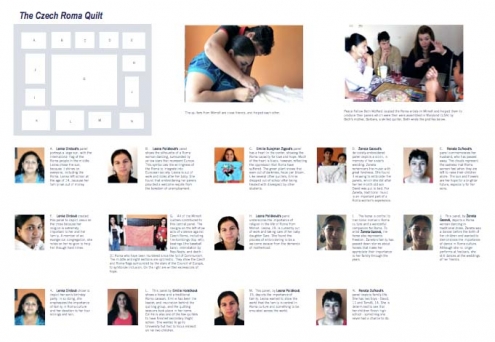Czech Roma Quilt
Background
Background
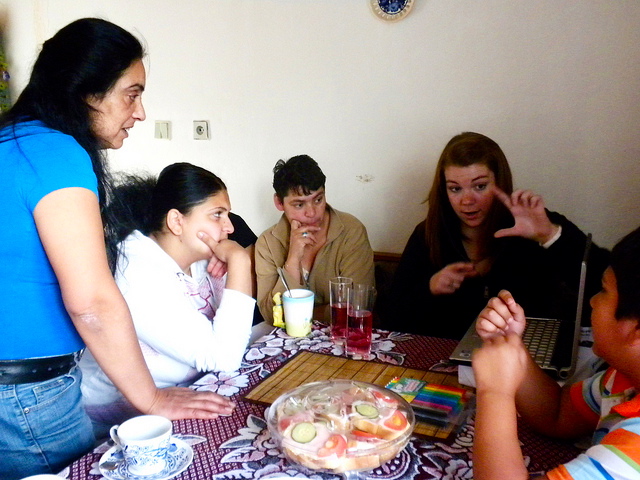 Getting Started: Peace Fellow Beth Wofford explains advocacy quilting to the Mimon group. In the summer of 2011, AP asked Peace Fellow Beth Wofford to develop a quilting project with a Roma community in the Czech Republic. Beth, from the University of Maryland, knew the Czech Republic from a previous visit but had no experience of quilting. Still, she was willing to try. Beth. Her host organization, the Dzeno Association, had taken several AP Fellows since 2003. Beth arrived to find Dzeno in disarray, but the director, Ivan Vesely, put out the word for partners through the Roma grapevine. Eventually Beth found a talented advocate and artist named Emilie Horackova in the town of Mimon, deep in Bohemia. Emilie organized a meeting over coffee for some friends and Beth, who shared photos of the Congo and Bosnian quilts. By the end of the day, they had a deal. 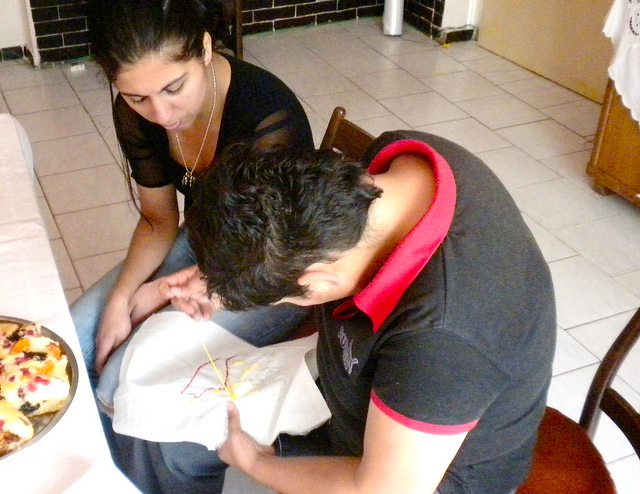 Helping Hand: Renata Dufkova Helps Lenka Pollakova with her square. Over the days that followed, the group worked together to sketch out designs, before starting their embroidery. (Pictured left: Peace Fellow Beth Wofford and Quilters Renata Dufkova and Lenka Dirdova). Twice a week, Beth would leave her apartment in Prague around 5:45am, taking the opportunity to nap on the bus to Mimon (photo). She also took time off to play with the children and grandchildren of her new friends. Beth asked Kerry McBroom, who had worked on the Dosta! Quilt, to visit from Paris and advise. The Mimon group decided on two broad themes – the cultural heritage of Roma and growing violence against Roma in the post-Communist Czech Republic. Each artist made her own tile. Leona Pollakova portrayed a woman dancing in a ring of stars. Emilie’s tile featured a horse, caravan, and campfire to reflect the strong oral traditional of storytelling among the Roma. Other tiles featured a violin, a dancing girl, and even the resurrection of Christ. The heart of the quilt, however, was less random. The six women worked together on a larger middle panel with a strong political message. The left side is meant to shock. It shows a house on fire, a baseball bat, and a swastika to illustrate acts of violence against Czech Roma community – fire-bombings, beatings, Neo-Nazi hate speech, and xenophobia. This left side also commemorates the 31 Czech Roma who were murdered between 1989 and 2011.  Music and Mobility: These two squares, by Renata, recall a time when Roma were always on the road and underline the importance of music in the life of Roma women. The right side of the central panel is optimistic: it uses the stars of the Council of Europe to symbolize peace and inclusion. The text loosely translates as: Budouchnost (Future); Chceme Dustojny Zivot Praci (We Roma women want dignified work); Vzdelání (Education); Bezpecnost Pro Sve Rodiny (Security for our families); Nechceme Sterilizaci (No to sterilization). Beth later wrote: “They put a lot of thought and effort into creating pieces which showcase the normalcy of their lives, while still including the underlying current of intense discrimination they are faced with everyday.“ Most of the women had never embroidered before, but they were guided by their coordinator Emilie and another quilter, Renata Dufkova, pictured left. (Renata helps Leona Pollakova to make her tile.) Emilie’s daughter, Emilie Sulejman Zigova, served as the unofficial translator between Beth and the other quilters. The only one of the women to have finished secondary school and attended university, Emilie proved vital to the success of the quilt. Although Beth spoke a small amount of Czech from her previous, it was not nearly enough to conduct these detailed discussions. The experience had a profound impact on the artists and on Beth, who later blogged: “My experience as a Peace Fellow would have been infinitely less rewarding if I had not found this group of women to work with. Their enthusiasm has kept my spirits high, and gives me so much hope for their futures. Emilie, our translator and newlywed, is already talking about expanding the project into Macedonia, where her husband is from. She told me how empowered she felt by being able to tell her story. The women in Macedonia, she told me, have even harder lives.” Early in October, Beth brought the tiles back to the US, where they were assembled into a final quilt by her mother, Barbara. This was captured by Beth in an affectionate video interview.  Light and Shade: The central panel depicts acts of violence against Roma, as well the prospects for peace offered by the Council of Europe. AP then took the quilt, together with the three other Roma quilts, to the third International Conference of Roma Women in Grenada, Spain. AP had secured an invitation for Emilie Horackova, who had coordinated the quilting in the Czech Republic, and Emilie was on hand to explain the designs (video). Emilie also intervened in the debate, to denounce discrimination against Roma in the Czech Republic – her first-ever appearance before an international meeting. Indeed, Emilie’s entry into the world of international Roma networking at Grenada was another welcome but unexpected outcome from the quilting experiment, and further proof that quilting can serve advocacy. AP reinforced the message by producing a video on the quilts in Granada, The Fabric of Life, which featured interviews with Emilie and Mimoza Pachuku, the coordinator of PROGRAEK in Kosovo. By the beginning of 2013, the Czech Roma Quilt was hanging at Kean University, alongside the four other Roma, bringing the Mimon to an American audience. |
Artists
Artists
|
Lenka Dirdová In the first panel, Lenka Dirdová, depicts a large sun, with the In her second panel, Lenka chose to depict her son’s birthday party. In so doing, she emphasizes the importance of family in Roma culture and her own dedication to her siblings and son. Lenka created the third panel to depict Jesus on the cross because her religion is extremely important to her and her family. A member of an evangelical congregation, she relies on her religion to help her through hard times. Roma families do not practice a single religion, like other ethnic groups, but rather absorb the religions of the area in which they have settled. Lenka’s story is similar to the other women working on the quilt. She left school at the age of 14, because of money pressures. As one of five siblings, she wanted to help out her family by finding a job. But she became pregnant at the age of 16, and stopped her job search to focus on her boyfriend and child. It is not clear if she is formally married. Now 20, Lenka spends most of her time caring for her son Daniel, 4, and her boyfriend. She is looking for work, but it is hard to come by. When asked if this is because she is Roma, she answers: “Maybe.” But it may also be due to the tough economic situation. “It is a hard time for everyone,” she says. |
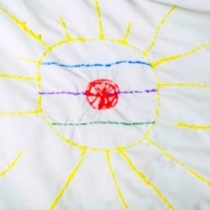 |
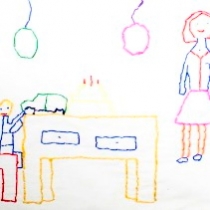 |
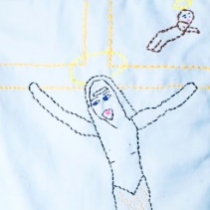 |
|
Žaneta Gazová The horse is integral to traditional nomadic Roma culture and a Žaneta displays one of her panels while holding her ten month-old son, David. The panel depicts a violin after the wedding of her sister-in-law and fellow quilter, Emilie Žigová. She says that although a violin is typically played by men, music should definitely be included among the quilt’s themes. The third panel, by Žaneta, depicts a Roma woman dancing in traditional dress. Žaneta was a dancer before the birth of her children and wanted to demonstrate the importance of dance in Roma culture. Although she no longer performs at festivals, she still dances at the wedding of her friends. Žaneta said that thinking of a design and turning it into embroidery has been a wonderful experience. She was often unable to work during the day, but worked on her panels after her young son David has gone to bed. (Any mother with a teething child knows how hard it can be to concentrate with an unhappy baby!) She describes the work as relaxing, particularly as it allowed her to spend more time with her other son, Dušan, who is 10 years old. She taught him how to embroider. He even lobbied to have his panels included in the quilt! Žaneta only got as far as Grade 9 in school. She says that she didn’t want to continue because it was so difficult to fit in with the non-Roma children. In addition, she said that she needed to make money rather than spend it on school. |
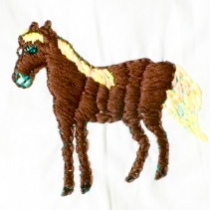 |
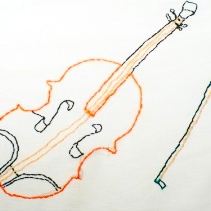 |
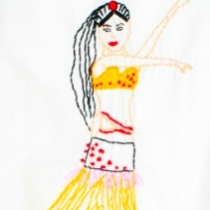 |
|
Leona Polláková In her first panel Leona Polláková mixes the literal with the figurative. In her second panel Leona depicts the importance of family. She wanted to show the world that the family is central in Roma culture and something to be emulated across the world. Leona is currently out of work and taking care of her own family, in particular one year-old Sara. Leona’s third panel is one of two with religious themes in this quilt. Leona wanted to demonstrate the importance of religion in the life of Roma from Mimon – although not all Roma share the same religion. Leona, 19, is currently out of work and taking care of one year-old Sara. She found the process of embroidering to be a welcome escape from the demanding task of being a mother to a young child. She says that she will start looking for work once Sara is old enough to go to school, but that in the meantime she needs to focus on making sure Sara learns Czech and grows up in the most loving environment possible. Leona did not go to school past Grade 9, and left when she was 14. She tried to find work but ended up getting married when she was 16, and was pregnant at 17 with Sara. She is 19 years old. Leona grew up in a family with ten children, and although she hopes to have more children one day, she says that ten is too many. Right now she is busy enough with only one baby! |
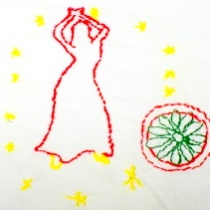 |
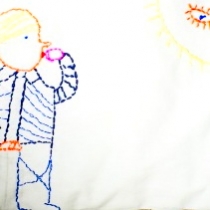 |
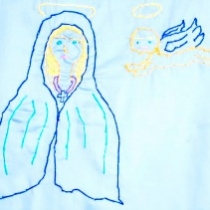 |
|
Emilie Horačková This panel by Emilie Horačková shows a horse and a traditional Roma She wanted to go to University but had to focus instead on her two children. She has been involved with social work in Mimoň for many years, and watched many of her fellow quilters grow into the women they are today. She helps at cultural events, such as dances, and attends the local evangelical church. Emilie is a wonderful blend of the traditional and modern. She did not want to have a lot of children, as she herself was one of ten brothers and sisters. She also made sure that her children finished high school, and her daughter even went to University |
| Emilie Sulejman Žigová
This lovely woman is Emilie Sulejman Žigová, our translator, The reason had nothing to do with the academic demands, but rather with the relentless discrimination she felt going into class every day. Her classmates (well educated Czechs) would ask her what she was doing in the classroom: “Are you here to clean up, gypsy?” Their lack of compassion led her to the difficult decision to leave and return to Mimoň, where she does social work for Roma alongside her mother, Emilie Horačková. Emilie Žigová created only one panel but did most of the other project tasks, including |
|
Renata Dufková vRenata Dufková’s panel commemorates her husband, who has passed Renata’s second panel depicts family life. She has two boys – David, 11 and Tomáš, 14. She says her children are expected to finish high school, something she never has a chance to do. She stopped her schooling after Grade 9, when she 14. High school students In the Czech Republic are expected to pay for their books, and often have to stay the night at the school because it is so far from where they live. Renata grew up in a large family – she was one of 18 children in a household. With many mouths to feed and children to take care of, further schooling simply wasn’t an option for her. Renata had a steady job for eight years, but was laid off due to the recession and has been out of work for two years now. Her life is hard, without a job and a husband to support her. She is trying her best not to abandon traditional Roma values, even though they are the reason why Roma women have so many children and get married so young. She said she would not want 18 children, as her mother had. However, if she is lucky, perhaps she will fall in love again and have more babies to bring more joy to her life. To Renata, family is the most important thing in life. She is doing her best to make sure her boys grow up feeling as loved and as cared for as possible. |
|
Mimoň Quilters All of the Mimoň Quilters contributed to this central The Swastika represents the growing trend of neo-Nazism in the Czech Republic – many members of neo-Nazi groups have been charged in attacks against Roma families and individuals. The crosses at the bottom represent the 31 Roma who have been murdered since the fall of Communism. The middle of the panel is optimistic. It shows a Roma flag and Czech flag are at the center, surrounded by the stars of the European Union. This represents the desire for inclusion by Roma throughout Europe. The dove at the top is the universal symbol of peace. The women who worked on the panel come from a Christian background, and hope that this will resonate with other Christian communities around the world. The right hand side lists hopes for the future. Loosely translated, they are: Budouchnost (Future); Chceme Dustojny Život Praci (We Roma women want dignified work); Vzdĕlání (Education); Bezpečnost Pro Sve Rodiny (Security for our families); Nechceme Sterilizaci (No to sterilization). The phrase in the middle, “Mimoň, ČR” refers to the village where the quilters live. |

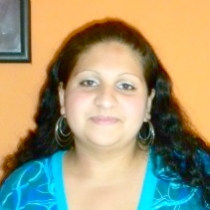 International Flag of the Roma people in the middle. Lenka said that the sun is for everyone because it shines down on everyone, no matter who they are or where they are from. She put the Roma flag in the middle to show the sun also shines on the Roma, and that non-Roma should realize that they do not have a privileged place in the world.
International Flag of the Roma people in the middle. Lenka said that the sun is for everyone because it shines down on everyone, no matter who they are or where they are from. She put the Roma flag in the middle to show the sun also shines on the Roma, and that non-Roma should realize that they do not have a privileged place in the world.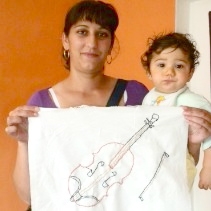 wonderful companion for Roma. To artist Žaneta Gazová, the horse also represents freedom. Although Žaneta’s family has been sedentary for decades, they have passed down stories about horses that make her appreciate their importance to her family through the years.
wonderful companion for Roma. To artist Žaneta Gazová, the horse also represents freedom. Although Žaneta’s family has been sedentary for decades, they have passed down stories about horses that make her appreciate their importance to her family through the years.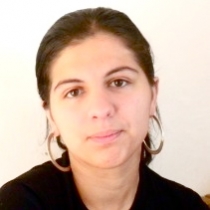 In the center is the silhouette of a woman dancing. Leona had been dancing since she was small, but stopped after she became pregnant. Surrounding the woman are yellow stars representing Europe, because discrimination is not just a problem in the Czech Republic – it is a problem across Europe. Among the stars is a green wagon wheel, a symbol of the Roma people. Leona hopes that this will show her people’s desire to be a part of the European community instead of being unwilling to assimilate – a common stereotype.
In the center is the silhouette of a woman dancing. Leona had been dancing since she was small, but stopped after she became pregnant. Surrounding the woman are yellow stars representing Europe, because discrimination is not just a problem in the Czech Republic – it is a problem across Europe. Among the stars is a green wagon wheel, a symbol of the Roma people. Leona hopes that this will show her people’s desire to be a part of the European community instead of being unwilling to assimilate – a common stereotype.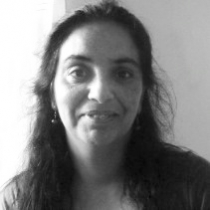 caravan. She is the leader of the group and the quilting sessions take in her home, which she shares with her daughter Emilie Žigová, Emilies’s new husband, Žaneta and Žaneta’s boyfriend. Emilie is one of the few quilters to have finished secondary (high) school.
caravan. She is the leader of the group and the quilting sessions take in her home, which she shares with her daughter Emilie Žigová, Emilies’s new husband, Žaneta and Žaneta’s boyfriend. Emilie is one of the few quilters to have finished secondary (high) school.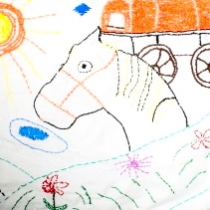 for three years. But in spite of her modern views of the world, her panel shows that she is devoted to traditional Roma culture. Although she is sedentary, her ancestors were nomadic and she wants to celebrate this. She dances and loves music, and wants her children and community to be proud of their culture, not ashamed. Non-Roma find it hard to appreciate the beauty of caravans and traditional music, and young Roma are also often forced to reject Roma traditions in order to fit in. But Emilie hopes that one day Roman culture can be appreciated by everyone, and not used to stereotype those of Roma descent – as sometimes happens in the Czech Republic.
for three years. But in spite of her modern views of the world, her panel shows that she is devoted to traditional Roma culture. Although she is sedentary, her ancestors were nomadic and she wants to celebrate this. She dances and loves music, and wants her children and community to be proud of their culture, not ashamed. Non-Roma find it hard to appreciate the beauty of caravans and traditional music, and young Roma are also often forced to reject Roma traditions in order to fit in. But Emilie hopes that one day Roman culture can be appreciated by everyone, and not used to stereotype those of Roma descent – as sometimes happens in the Czech Republic.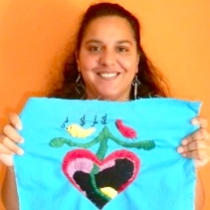 newly-wed, and all-round adorable human being! Emilie was the only one of the quilters to complete her secondary school education and begin a career at University. Sadly, she decided to drop out of University with only one year left before graduation.
newly-wed, and all-round adorable human being! Emilie was the only one of the quilters to complete her secondary school education and begin a career at University. Sadly, she decided to drop out of University with only one year left before graduation.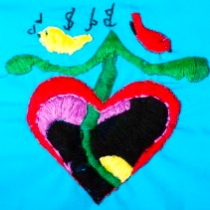
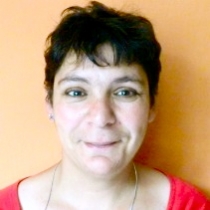 away. The clouds represents the sadness that she and many other Roma women feel when they are left to raise their children alone. The sun and flowers are her hope for a brighter future, especially for her family.
away. The clouds represents the sadness that she and many other Roma women feel when they are left to raise their children alone. The sun and flowers are her hope for a brighter future, especially for her family.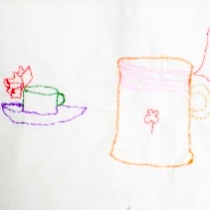
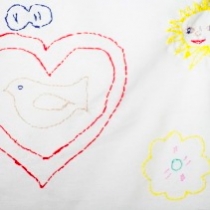
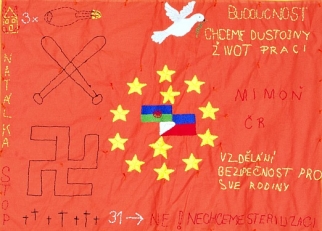 panel. The left hand side recounts atrocities against Roma in the Czech Republic since the fall of Communism. At the top left there is a burning home with “3x” next to it. This refers to the three worst firebombinbgs against a Roma home. Next to the “3x” is a Molotov cocktail, which was probably used in the attacks. Running down the left-hand side is “Natalka,” the name of a 2 year-old girl who was severely injured in one firebombing. The baseball bats refer to numerous beatings.
panel. The left hand side recounts atrocities against Roma in the Czech Republic since the fall of Communism. At the top left there is a burning home with “3x” next to it. This refers to the three worst firebombinbgs against a Roma home. Next to the “3x” is a Molotov cocktail, which was probably used in the attacks. Running down the left-hand side is “Natalka,” the name of a 2 year-old girl who was severely injured in one firebombing. The baseball bats refer to numerous beatings.